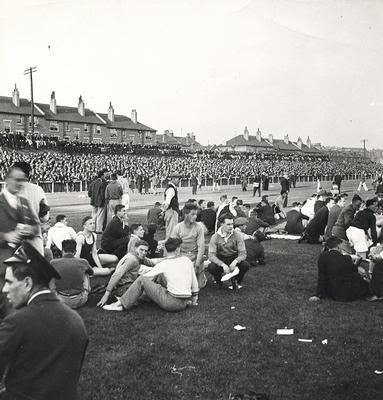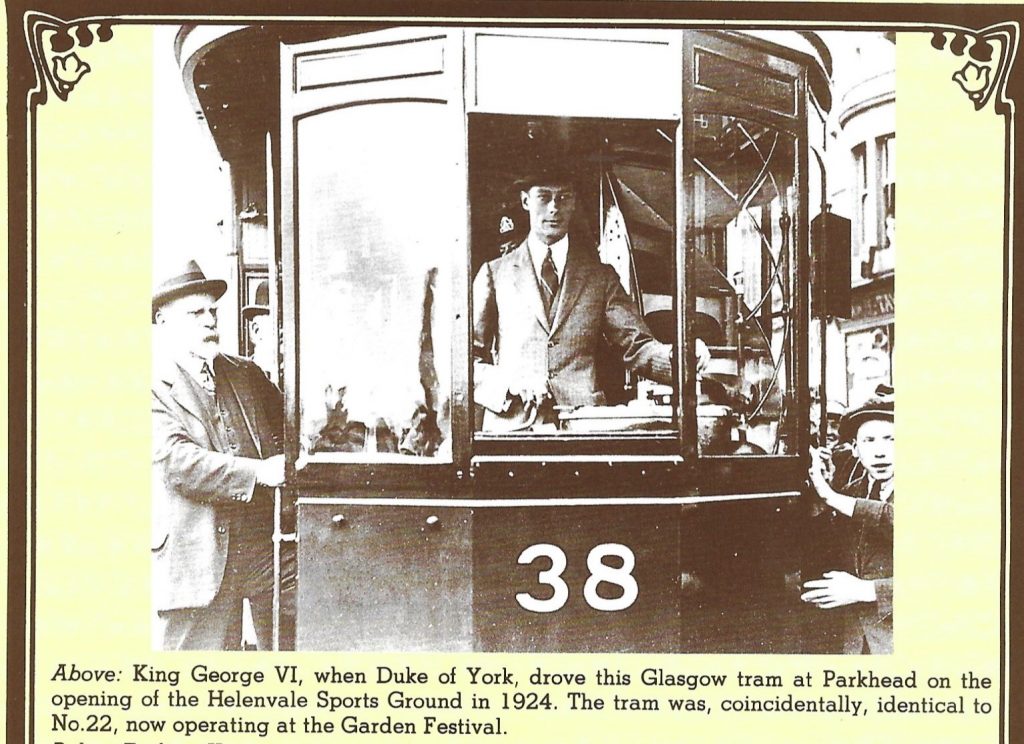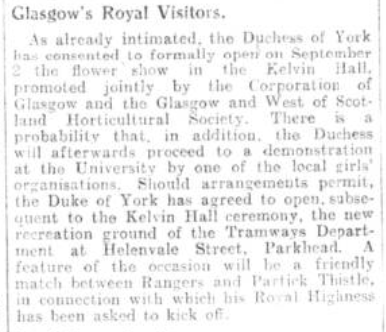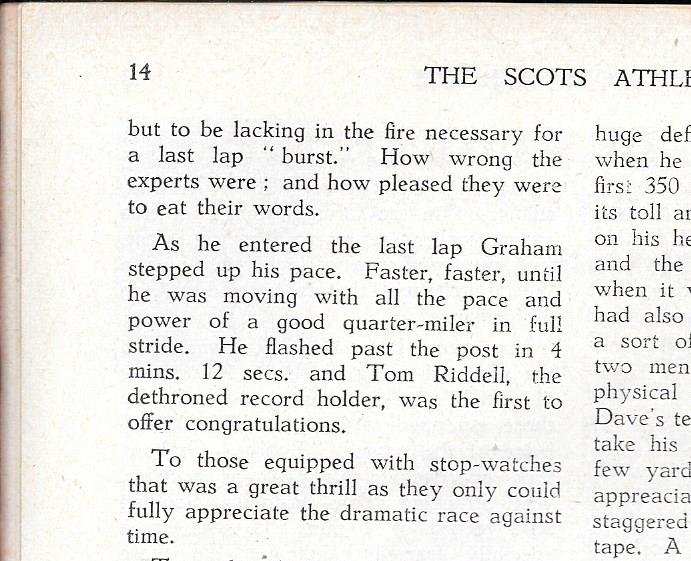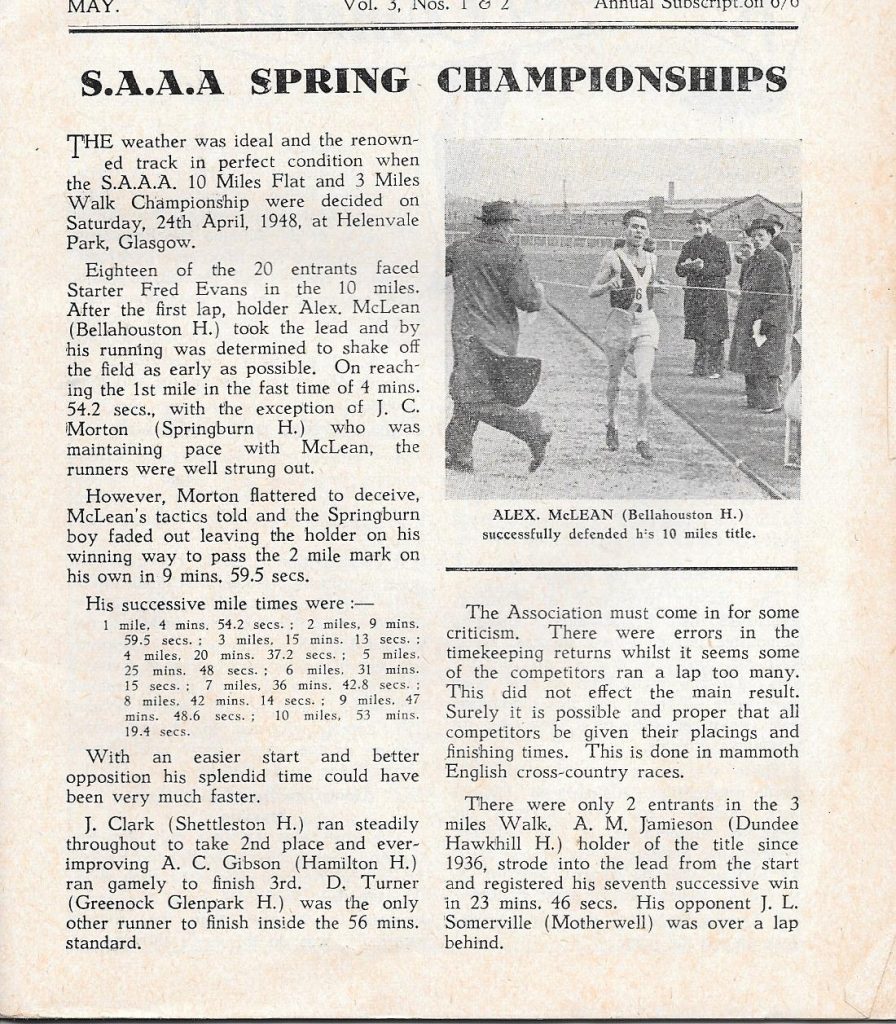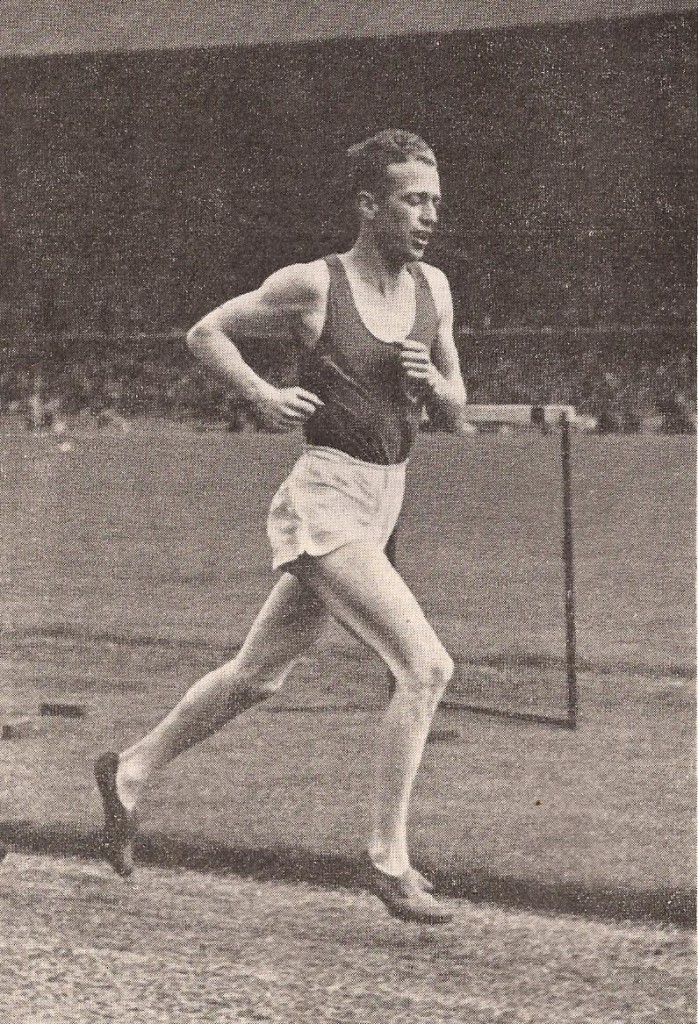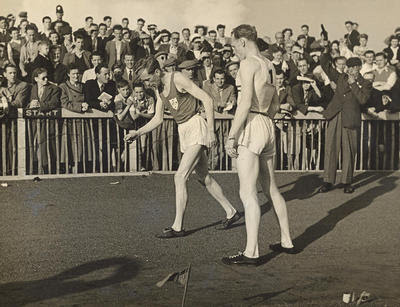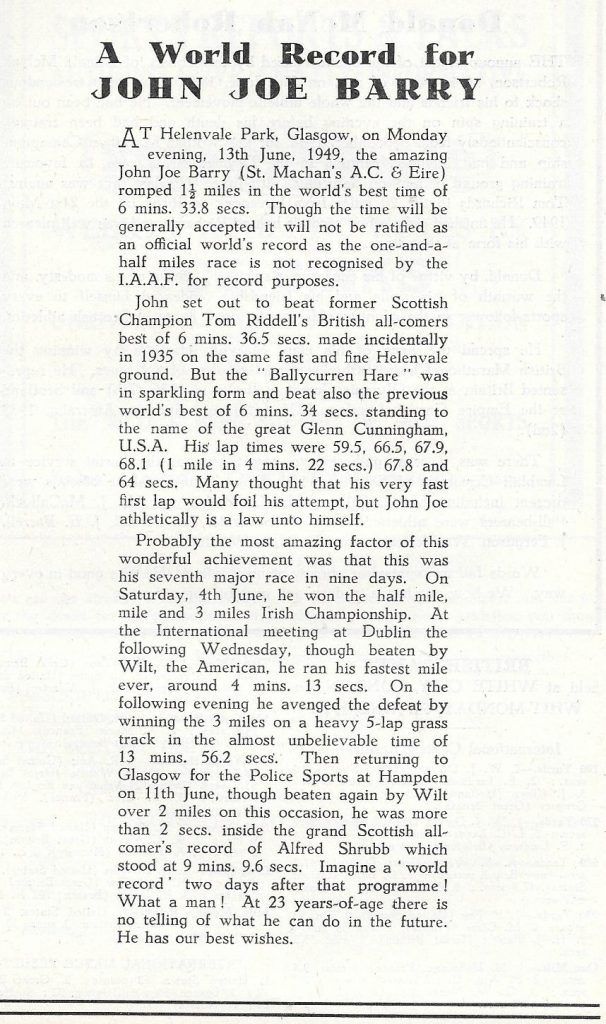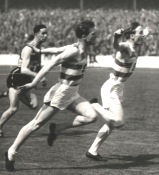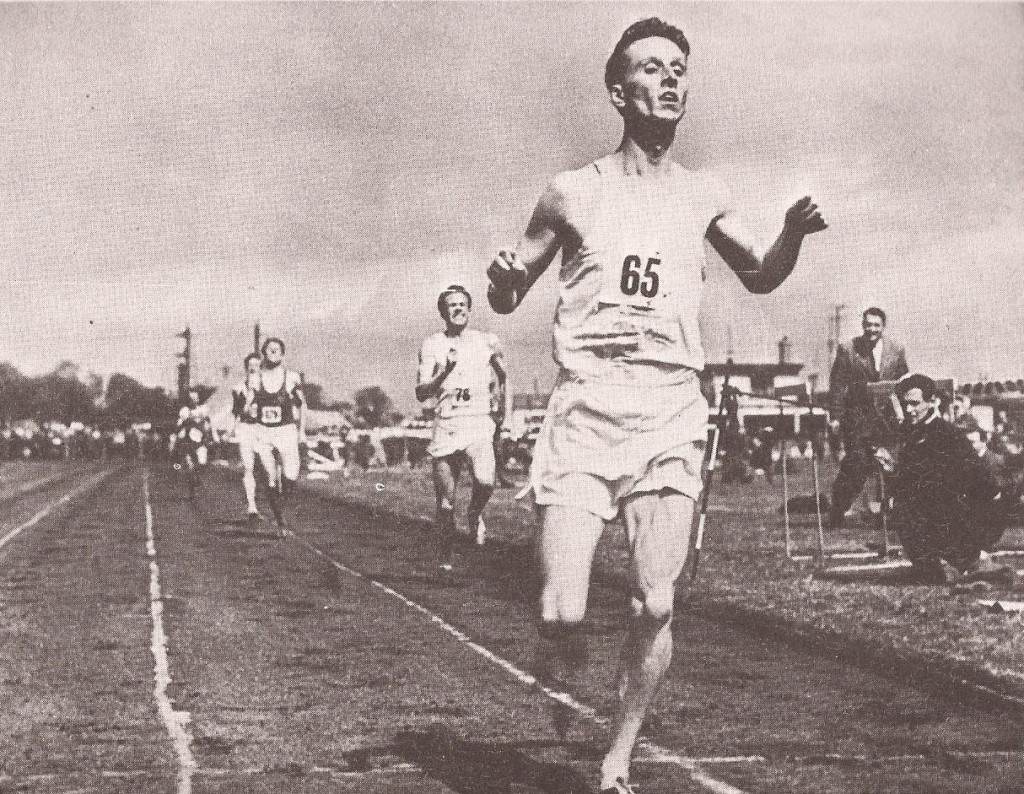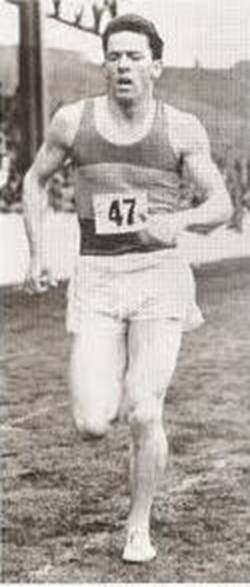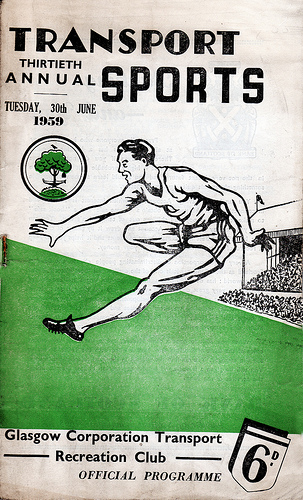Helenvale in the 1950’s
One of the most popular athletics meetings in the West of Scotland for several decades was the Glasgow Corporation Transport Department Sports (it was actually known as the Glasgow Tramways Recreation Ground) at Helenvale held in the evening, mid-week, it attracted at one time or another most of the big names in Scottish athletics and national records were set at the meeting. It was a narrow track and the terracing was relatively small compared to, say, Ibrox or Cowal so that the crowds which turned up (see the photo above) created a tremendous atmosphere. There are many stories about the venue – Dunky Wright getting carried away at a long sprint finish between Alex Brown (Motherwell) and Harry Gorman of Springburn referring to the leader at one point as ‘Harry Springburn’. In this short article we can concentrate on the post war period, particularly the 1950;s which were arguably the heyday of the Glasgow Transport Sports Meetings.
According to the canmore.org.uk website in 2014 : “The Helenvale Sports Ground, constructed in 1924 by Glasgow Corporation Transport for the use of their staff. The opening ceremony was performed by the Duke of York and featured a football match between Rangers and Thistle. The sports grounds consisted of an oval pitch/ track for football and athletic events alongside bowling greens and a tennis court. The site is understood to have been adopted by Glasgow City Council in the 1970s as a public sports grounds.”
The photograph above is from the brochure issued for the Glasgow Garden Festival in 1988. The site was indeed opened in 1924 and was previewed by the following article from the ‘Edinburgh Evening News’ of 14th August. (On the day the article appeared, The Tramways Dept. Sports were held at Shawfield Park, by permission of Clyde FC)
The scheduled visit by the Duke and Duchess on 2nd September did take place and the ‘Glasgow Herald’ of 3rd September reported fully on the events of the day and the various functions attended by the royal couple. The sub-head on the page read “Opening of Tramways Ground by His Royal Highness” and the relevant paragraph read:” Proceeding to the Recreation Grounds of the Tramways Department, a halt was made en route when His Highness mounted the platform of a Transport Department tramcar and, under the guidance of Mr James Dalrymple, general manager, drove it a short distance through the streets to the Dalmarnock Depot. Before undertaking this duty, the Duke of York “signed on” as other employees do. At the Recreation Grounds His Royal Highness opened the football pitch by kicking off in a match between Glasgow Rangers and Partick Thistle much amusement being caused by the boldness with which he caried away the headgear of a Press photographer with the shot. The Duke also opened the Tennis courts and bowling greens and later visited the pavilion.”
He then headed for Queen Street Station where me met the Duchess and the left town on the 5:00 train going north on their way to Glamis.
Meetings then continued right up to the start of the war in 1939.. Two in particular were looked back on fondly by James L Logan of Victoria Park in 1948 –
A much loved arena by athletes, it was pressed into use immediately after the 1939-45 War for the SAAA 10 miles championship. The very first issue of the excellent ‘Scots Athlete’ magazine, edited and produced by Walter Ross, came out in April 1946 and the following preview of the race by Emmet Farrell are worth reading:
“Who will be the first Scottish champion of the post war era? Resumption of the 10 miles track championship takes place on Saturday, April 27th at Helenvale Park and should provide a yardstick of comparison with pre-war form. As most of the contenders will be found from the ranks of the ill-fated international cross-country team it would be difficult indeed to predict a probable winner. Favourite prior to the international would have been JE Farrell but if Jim Flockhart elects to start he has shown that in the mood he is still a menace to the best of Scotland’s distance experts.
The choice of Helenvale Park as the venue may be open to criticism. For while the cinder track is excellent, the short track may provide time-keepers with a lot of headaches, but with Fred Evans in charge of his own track arrangements should go smoothly.“
Despite Emmet’s reservations, the championships went ahead and in the next issue of the magazine the following report appeared.
THE S.A.A.A. SPRING CHAMPIONSHIPS REVIEWED
by T. A. GOURLAY
The above meeting was held at. Helenvale I’ark. Glasgow, on Saturday. 27th March. 1946, after a laps.- of six years. The track was in fine condition and the weather was dry, hut a trouble¬ some wind was blowing down the stand straight. The first event to be decided was the 10 miles track championship. Thirty runners, a record number for this event, faced the starter, .Mr. Fred Evans, lining up in three rows across the track. Of the six non-starters announced the most notable was J. C. Flockhart. After his running at Ayr in the ” International,” it was thought that he would be a strong chaIlenger to J. E. Farrell, Maryhilll Harriers, who was defending his title. A young newcomer, J. Harbour. Dundee, Hawkhill. led the field for the first three laps and lost this to A. McLean of Bellahouston. who took the lead at the end of the first mile, which was reached In 5.18. The other runners close on his heels at this point were A. McDonald, Auchmountaln: Farrell, Maryhlll: and MoLennan. Shettleston. Coming near the end of the fourth mile. McLean was still leading. closely followed by J. Farrell and McLennan, Shettleston, and the ultimate winner seemed to be among these three. Harry Howard, Shettleston, running in the middle of the field, retired at four miles. Almost at half distance. J. E. Farrell took the lead for the first time, with McLean and McLennan interchanging places for a few laps. The time at 5 miles was 27.13. in the next mile the champion, running strongly, considerably Increased his lead. It Is interesting to note that the sixth mile was done In 5.19. This was, I think, the deciding point of the race. McLean was now a clear second, Mclennan having fallen back with A. McDonald, Auchmountain, running third. Tho first three positions did not change, and J. E. Farrell ran out a winner in 54.38 3/5, about 250 yards ahead of A. McLean, with A. McDonald 3rd, and J. Lindsay, Bellahouston. 4th; C. McLennan,.5th: A. I Hay. 6th: A. McDonald and J. Lindsay gaining standard by finishing inside 50 minutes. I make tho following points which may be of Interest. I think A. McLean may have been nearer the winner if he had not held the lead for so long in the early stages, A. McDonald finished In the same position in this race 11 years ago. I think John Lindsay, Bellahouston, will look upon this as one of his best performances to date. There were a few young runners who, I think, would be well advised to refrain from competing in this race for a year or two. The following table shows leader’s time at the end of each mile. It may prove of interest to the “student of form” and also of service to future entrants In preparing a Time Schedule for standard time qualification:—
1st mile .. 5 min 18 sec 2nd Mile .. 5 min 30 sec 3rd mile .. 5 min 29.4
4th mile .. 5 min 24.6 5th mile .. 5 min 31 6th mile .. 5 min 19
7th mile .. 5 min 33 8th mile .. 5 min 34 9th mile .. 5 min 36.6
10th mile .. 5 min 23
The 3 miles walking championship only attracted four starters, including the holder, A. M. Jamleson. Dundee Hawkhill. The champion Jumped Into the lead at the start, and with Ills snappy action soon set up a big lead and eventually won by over -100 yards from Crossley, Edinburgh II. The winner’s time was 24 mins. 7.0. Without any intention to detract from the worthy performance of the Dundonian in winning the title for the fifth successive time, this event did not come up lo championship standard It is a fact that this event just escaped excision from the S.A.A.A.”s list of championship events and.judging from the meagre support which has been given to it in pre-war years It would appear to he in danger of complete extinction in the near future. True, this race has been endowed with a handsome Challenge Trophy, gifted by the late George Hume, a walking enthusiast, but even this circumstance may not save the event from its distinction as a Championship item in the S.A.A.A. sports calendar unless better support is forthcoming.
Incidentally,in the dressing room I heard complimentary remarks regarding the track and the washing facilities. These particularly were greatly appreciated. The attendance was not large hut the enthusiasm was there. “
The following year the championships were held at Helenvale on 26th April and it was another good race. The report this time read
S.A.A.A. SPRING CHAMPIONSHIPS
By THOMAS CRUDEN
(Hon. Secy., Renfrewshire AAA.)
“A fairish crowd of Club members and old-timers came along to Helenvale Park to give vocal encouragement to the contestants in the S.A.A.A. Spring Championships, on Saturday, 26th April, 19-17. Starter Fred Evans sent a full turn out of 10 away on their long. long trail in the 10 miles, and as soon as the field turned into the strong wind that was blustering down the finishing straight, there began a game of ” wait and see,” among a group of 10, nil more or less reluctant to assume the punishing role of pacemaker. This went on for fully three miles, with the holder, J. E. Farrell (Maryhill), never allowing himself to get “boxed,” yet never taking the lead: a tactical manoeuvre which looks so easy—until you try it. A third mile of 5.35 — obviously this could not go on. and at 8 miles Farrell suddenly dashed down the stand straight with the wind at his back. The race fizzed up: two more helter skelter rushes in the next laps spreadeagled the field, leaving only Farrell, A. MacLean (Bellahouston H.) and A. McLennan (Shettleston H.) running together. Half-distance in 27.7 (good for the conditions), and then MacLean challenged the holder at his own game by piling on the pace down the back straight. The sixth mile, second fastest of the entire ten. was the deciding point of the race: MacLenn’s electrifying dashes downwind Increased his load over Farrell by 15 yards each lap. and finished Mclennan.
One wondered: was the leader burning up his energy too soon by these spurts? — would Farrell’s strength enable him to pull in the Bellahouston man in the closing laps? But at the start of the seventh mile It was apparent that the holder was beaten. His rhythmic style had given way to a laboured, rolling gait ; barring collapse. MacLean was a certain winner. And there was no sign of the leader collapsing. He continued to spurt like a miler and. at the bell, was on the point of lapping his clubmnte Anderson. With the race in his pocket, he sportingly refrained from passing Gaby, which meant that S.A.A.A. Secretary, Mr. Gilbert, had to give a nimble performance by darting through the three-yard gap between the Bellahouston men. to unreel the tape for a very worthy and popular champion. Farrell plodded on to finish 300 yards behind, and the steady Anderson was a good third. Result:—
1 A McLean, Bellahouston H: 54:32; 2 JE Farrell, Maryhill Harriers 55:28.8; 3. G Anderson, Bellahouston H 55:45.”
*
That Helenvale track – as opposed to the entire facility – was a good one, led Emmet Farrell to comment in July 1947 after the SAAA Championships had been held at Hampden Park:
“To my mind, Hampden Park is not the ideal setting for our championships. Competitors are too detached from the spectators – many fine points are lost because of the distance. Could the SAAA not endeavour to get an arrangement for an reconstructed Helenvale? Once it is possible to carry out enlargements to the existing stand, and the improvements on the terracing, with the present track, which is second to none, it would be the ideal place for such a meeting; allowing a necessary link up with athletics, officials and spectators.”
His thoughts might have been refined by the fact that the SAAA championships were on the 21st and 22nd June, while the Transport Sports were on Tuesday 24th and he could compare them with some accuracy.
Note the dates. The Transport Sports were usually the Tuesday after the national track and field championships and so coverage was scanty – the events were not always reported in the Press.
The championships were held at Helenvale for the third time in 1948 and we have the report from the ‘Scots Athlete available again.
*
*
The real high spot for Helenvale as an athletics venue was the night of 13th June, 1949 when John Joe Barry set a world record at the venue. A world record set in the east end of Glasgow in a handicap race against the top Scottish runners. The Glasgow Herald report the following day said:
John J Barry, the St Machan’s and Clonliffe Harriers (Eire) runner created a world record for the one and a half miles at Helenvale Park last night when at St Machan’s sports meeting he covered the distance in 6 min 3.5 sec. Barry’s time was 2-10ths faster than the previous best made by Glenn Cunningham (USA) in 1937, and 2.7 sec faster than the British record made by Tom Riddell (Shettleston) in 1935. Withe Scottish Mile and Three Miles champions J Fleming and A Forbes running from 20 and 25 yards respectively, Barry covered the first mile in 4 min 22 sec and had his field well in hand. Round the last lap he put in a superb effort to beat W Lennie (Vale of Leven Harriers) to whom he was conceding 85 yards, and won by 30 yards.
Another Irishman, Paul Dolan, failed by 2-10th sec to beat the late Capt Halswell’s record for 300 yards. Principal results:
100 yards: W McFadden. Garscube (7) 10.1 sec; 220 yards: W McFadden (14) 22.8 sec;
300 yards: I Sutherland, Victoria Park (18) 31.3 sec; (Paul Dolan, Clonliffe Harriers was second in 31.4 sec)
880 yards: F Jewell, Garscube, (18) 1 min 59.4 sec. Mile: JD Stirling, Victoria Park (105) 4 min 22.6 ; Pole Vault: DM Hastie, Hillhead HS FP (3 in) 11 ft;
Five a Side Football: Partick Thistle 4 (Howitt 3 Mather) Third Lanark 0
It was a marvellous feat and the specialist athletic magazine had to say its piece and in the June 1949 issue, the ‘Scots Athlete’ magazine reported thus:
Proof of the quality of the track if any were needed. But note also that the winners were ordinary club athletes competing in handicap races, changing in the same dressing rooms, sitting side by side on the infield with the top men. It was a feature of such meetings as the Rangers Sports in Glasgow and the Edinburgh Highland Games at Murrayfield at the time. The inspirational effect on club runners was great.
In 1950 the Glasgow clubs inter-club championship was scheduled for Helenvale on 13th June but the big event was the one to be held later in the month. Despite the fact that the Transport event was on 27th June only four days after the SAAA Championships, where he had won an epic Three Miles victory over Andy Forbes, in 1950, John Joe was back in action. This time he won the mile in the excellent time of 4:12.1 – only 1.1 seconds outside Wooderson’s all-comers record. His lap times were 61, 64, 66 and 61.2 against the Englishman’s 60. 64. 66 and 61. Incidentally John Joe ran the next day in Dublin where he won the Two Miles Invitation from Douglas Wilson – and Andy Forbes – in a world record time. The ‘Scots Athlete’ commented on the relay in its July 1950 issue as follows: “Once again it was proved that when athletes are in good form, the Helenvale track is the place to do justice to it. Glasgow University whose men ran with grace and verve beat Bellahouston Harriers great record of 3 min 32.9 sec set up in 1938 by 1.2 sec – the new time being 3 min 31.7 sec.” The winning team was Tom Begg, Robin Ward and JH Paton, and DK Gracie.
1951 saw two fixtures listed for the ground. The Scottish National Cyclists Union had their meeting at Helenvale on the 19th of the month and the Sports dated for the Tuesday after the big SAAA event on 26th June and it was not covered in any significant way. 1952 was Olympic year and the SAAA championships were held early in the month – 6th/7th – and the Transport Sports, as though joined at the hip, were held on 10th June. They maybe thought that coming just after the SAAA meant that there would be more athletes in good shape and aiming to redeem themselves or to confirm their form. It would have been interesting to see what would have happened had the stuck to the ir usual Tuesday at the end of the month. However it turned out to be a great evening with the Scottish record being equalled by Willie Jack of Victoria Park. The Glasgow Herald report read
“The outstanding performer at Glasgow Transport sports at Helenvale track last night was W Jackj (Victoria Park AC), the Scottish 100 and 220 yards champion, who from scratch in a special 100 yards handicap returned 11.6 seconds and equalled the Scottish record established by A McCorquodale four years ago. DK Gracie, the Scottish 440 yards hurdles champion, attempted to improve on his recent all-comers record performance of 54.7 seconds but returned 55.7 seconds. F Evans (Manchester AC) was at scratch in a special 880 yards race and finished second to R Stoddart (Bellahouston) who was in receipt of 32 yards. The winner accomplished the very fast time of 1 min 52,2 sec.”
The winners of the principal track events were
100 yards: KM Donaldson, Victoria Park (6) 9.8 sec; 220 yards: KM Donaldson (18) 22.7 sec;
880 yards: GR Robertson, Shettleston, (34 yards) 1:57.6; Mile: F Scally, Shettleston,(125) 4:20.8
Two Miles: E Bannon, Shettleston, 9:23.5. Team: Victoria Park.
Mile Medley Relay: Manchester AC .
Maybe they were right to keep to the ‘Tuesday after the National ‘ pattern after all.
Willie Jack beating club mate Bobby Quinn
The 1953 fixture list only had the one Helenvale entry and that was for the first Tuesday after the national championships – 30th June. The headline and report in the Glasgow Herald’ on the Wednesday read
“ANOTHER RECORD FOR BRECKENRIDGE
AD Breckenridge (Victoria Park AC) Scottish mile champion and record holder maintained his record breaking form at the Glasgow Transport Sports at Helenvale Park, Glasgow last night. Breckenridge won a special two miles scratch race in 9 min 5.6 sec – 7.8 sec better than the previous Scottish native record for the distance set by PJ Alwell 15 years ago.Breckenridge was only 0.4 seconds outside the Scottish all-comers record set by F Wilt (USA) four years ago at Hampden Park. One of his rivals was JJ Barry (USA and formerly Eire), the holder of the mile and a half world record. It was said on behalf of Barry before the race that he was running against doctor’s orders and it was evident before half a mile had been covered that he would be unable to stay the pace set by Breckenridge. At the end of one mile, Breckenridge recorded the fast time of 4 min 28 sec, and at a mile and a half 6 min 49.9 sec. Barry finished well to beat AD Forbes (Victoria Park) for second place.”
The main track results for that night were
Invitation 120 yards: 1. DK Gracie (Larkhall) ; 2. R Whitelock (Victoria Park); 3. W Jack (Victoria Park) Time 10.2 seconds
440 yards: 1. D McDonald (Garscube Harriers); 2. JB Hume (Clydesdale Harriers) ; 3. JE Robertson (Edinburgh Northern H) Time 49.8 seconds
880 yards: 1. JS Hamilton (Victoria Park); 2. WS Linton (Braidburn AAC); 3. JB Petty (Bellahouston Harriers) 1 min 54.6
Medley Relay: 1. Victoria Park (Hamilton, Jack, Whitelock, R Quinn) 3:32.7
[About the medley relay – the VPAAC team lead off man Hamilton had won the SAAA Championships on the Saturday, and Jack, Whitelock and Quinn were 1,2,4 in the 100 yards final and 1,3,4 in the 220 yards final. In the 100 final, the club actually had four in four with Dunbar being second!)
*
The 1954 fixtures included one at Helenvale on 15th May in the form of the Glasgow & West PO Telephones AC and the report was headlined “BINNIE’S FAILURE AT HELENVALE” and read “I Binnie (Victoria Park) holder of 19 records, including 7 British, failed at Helenvale Park to do himself justice in his attempt on the hour run and to find out how near to the world record for 20,000 metres he could get. When two miles of the fast track had been covered he was as much as 6.9 sec worse than his time for the distance at Dunoon last August and he never showed any signs of recovering. He finished 920 yards behind the distance of 11 miles 1576 yards which he accomplished at Dunoon. His time for the 20,000 metres was 65 min 51.6 sec – 6 min slower than the record of E Zatopek. H Fenion (Bellahouston H) clocked 66 min 31.2 sec.”
Some other results from the night: 100 yards/220 yards: G Rodger (Clydesdale) 7 1/2 and 16 yards; 880 yards: A Small, (Plebeian H) 26 yards; Mile: I Cloudsley (Shettleston) 150, 15 miles road race: H Lawrence (Teviotdale H); there were also cycling, wrestling and five-aside football in which Celtic beat Third Lanark 4-1.
In the Transport Sports on 29th June there were good performances but no records or record equalling feats on view. On a cold, wet night, the two miles was the race of the evening: won by John Stevenson of Greenock Wellpark from his brother Tom with Eddie Bannon (Shettleston) third. Despite only needing three to score for the team race, Wellpark were second n the team race – one point behind Victoria Park. J McLauchlan (Maryhill – 3 yards) won the 120 yards special short handicap invitation from D McDonald (Garscube – 2 yards) and R Quinn (VPAAC – 1/2 yard) was third. Jack Brown of Dumbarton won the 220 and Eddie Sinclair (off 145 yards) won the Mile.
This successful meeting was held again in 1955 but results are not available, however in 1956 it was on 26th June that the faithful made their way to the venue. The ‘Glasgow Herald’ heading was a prosaic GLASGOW TRANSPORT ATHLETICS MEETING and the very short review read
“PM Connolly (Jordanhill Training College) was a convincing winner of the special 120 yards short limit handicap at Glasgow Transport Sports at Helenvale Park last night, beating AS Dunbar (Victoria Park) the Scottish 100 yards champion from whom he was receiving three yards. There was a following wind. JG Robertson (Glasgow University) was a close third off two yards. Interest in the two miles team race was reduced because of the absence of GE Everett (Shettleston Harriers) who was reported unable to take part because of a slight chest infection.”
The principal track results:
Two Miles – Individual 1. A Brown (Motherwell) 9:10.2. Team: Bellahouston: FG Nelson 2, J Connolly 5, R Penman 10 = 17 pts.
Mile Medley Relay: Victoria Park AAC: J McIsaac, AS Dunbar, JV Hamilton, R Quinn. 3:35.3
It was still a good meeting but the atmosphere was changing slightly. However, given the SAAA habit of moving championships around to different venues, the West District Track and Field Championships came to Helenvale on 4th June 1957. With the Transport Sports on 25th June, it looked like a good month. The West District championships were held on two nights – Tuesday 4th and Thursday 6th June. The Mile was one of the first events to be decided and Graham Everett won Hendry (also Shettleston) and WJ More (Kilmarnock). The 440 hurdles were won by Hunter of Jordanhill and the 440 by J McIsaac (VPAAC) from Boyd and Paterson of Glasgow University. Robertson of Glasgow University won the 100 yards from Dunbar of Victoria Park but the most exciting race of the night was the Six Miles. Andy Brown (Motherwell) with 30:29 won from Ian Binnie (VPAAC) and Bobby Calderwood (VPAAC). Came the Thursday session and the main actors were Robertson who ‘did the double’ by winning the 220 yards, and Brown who did his own double by winning the three miles, winning in 14:18.3. Fraser of Bellahouston won the 880 yards from Boyd (GUAC) and More (Kilmarnock) in 1:55.8.
JV Paterson
For many of the athletics watching public, a good hard fought half mile race is the most exciting thing in any track contest. A mix of speed, skill and stamina, not forgetting the elbows on the bends, it can be a wonderful spectacle. In the Transport Sports at the end of the month the most talked of event was just that event.
“HALF MILE DUEL IN GLASGOW
Transport Sports
JV Paterson (Edinburgh University), holder of the Scottish 440 and 880 yards titles, and GE Everett (Shettleston Harriers), holder of the national one mile title, were the chief rivals in a special 880 yards invitation race last night at the Glasgow Transport sports. Paterson won the event in the splendid time of 1:52.4 – 0.7 sec better than the time he returned in winning his half mile title last Saturday at New Meadowbank, Edinburgh. Paterson won by two yards. Everett returning his best personal time of 1:52.7 for the distance.”
The other winning track times:
100 yards: J Young, Springburn (3 1/2) 9.9 sec ; 220 yards: AG Watson, GUAC, (6 yards) 21 sec;
880 yards: WJ More, Kilmarnock (22) 1:54.2; Mile: RH Smith, Victoria Park (125 yards) 4:08.9;
Two Miles: Individual L Hendry (Shettleston) 9:18.8; Team Bellahouston Harriers.
Everett enjoyed the half-mile in 1957 so much that he was back, running the same event – invitation, short handicap, special 880 yards – from scratch in 1958. In the absence of Paterson his rival on the scratch mark was Donnie McDonald of Garscube, a fine quarter and half miler who was the Scottish champion at the latter distance. Coming through the quarter in 55.3 Everett set a new personal best of 1:51,6. There were many whose names would become familiar to the point of being household names competing that night – Crawford Fairbrother won the high jump with a clearance of 6′ 5 1/2″, with Alan Houston (both VPAAC) second with a jump of 6′ 3 1/2″. Ian Harris of Beith (international cross country runner who would go on to win the SAAA Marathon title. won the mile and Joe Connolly of Bellahouston won the two miles in 9:10.0.
The following year’s report was brief and didn’t really report on the events at all. It read, in its entirety, as follows: “R Whitelock (Victoria Park), the Scottish 100 yards champion, broke his collar bone when he fell at the finish of the 100 yards handicap at the Glasgow Transport sports last night. Whiteloock running from scratch stumbled in his finishing burst with which he took second place in 9.8 seconds. The team contest was won by Victoria Park with 13 points.”
Mike Ryan of St Modan’s a future world class marathon runner, won the mile in 4:08 and Andy Brown of Motherwell YMCA won the two miles in 9:03.8.
The track and the meeting progressed through the 1960’s and into the 1970’s there was certainly a meeting held in 1971.. If it were so popular, why did it go? There were at least three reasons that come to mind:
First the meeting was typical of many that had drawn massive crowds and top athletics talent alike to tracks around Glasgow in the 1950’s – Rangers Sports, Glasgow Police Sports, and so on. Many had already gone. The Rangers Sports had ceased to be in 1962, and maybe events like that put on at Helenvale had outlived their time.
Second, the Commonwealth Games had come to Scotland in 1970 and did wonderful things for the sport: it certainly raised the profile of the sport and provided the youngsters as well as the ordinary club athletes with role models and exemplars in whose footsteps to follow. Although three of the athletes selected for the Commonwealth Games in 1970 competed and won there (Les Piggott, Mike McLean and Lachie Stewart) in Games year, it’s days were numbered.
Third, Helenvale (and that’s what this is supposed to be about, was a good cinder track . There had been an allweather track at Grangemouth since the mid 1960’s, Coatbridge was not far behind, Meadowbank had its new state of the art track by 1969 – and Glasgow lagged behind. There were newspaper articles backed up by comments from international athletes about the lack of any all-weather track in Glasgow. Scotstoun and Westerlands which were used for championships and international meetings were still cinder. The athletes were looking for other surfaces to run on.
For all these reasons, Helenvale stopped holding their popular meetings and eventually the ground was used for other things by the city. At one point in the 1980’s Eddie Taylor, when he was Scottish Staff Coach for multi-events, thought he could use it as a kind of centre of excellence for the various disciplines but nothing came of that. However, we have not yet looked at the pre-war period of which James Logan had such memories – we will have to go there.
The available coverage of the sports between 1925 and 1939 is available here
